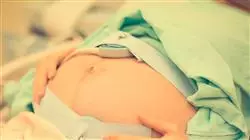University certificate
Scientific endorser
.png)
The world's largest faculty of nursing”
Introduction to the Program
After passing the evaluations of the Masters Degree in Obstetrics for Midwives, the professional will have acquired the necessary professional competencies for a quality and up to date practice based on the latest scientific evidence.

With this program you will be able to master the new therapeutic procedures and provide the best care in Obstetrics for Midwives”
General Skills
- Possess knowledge that provides a basis or opportunity to be original in the development and/or application of ideas, often in a research context.
- Apply acquired knowledge and problem-solving skills in new or unfamiliar environments within broader (or multidisciplinary) contexts related to their field of study.
- Integrate knowledge and face the complexity of making judgments based on incomplete or limited information.
- Communicate your conclusions, your knowledge and the ultimate reasons behind them to both specialized and non-specialized audiences in a clear and unambiguous manner.
- Manage the learning skills that will enable them to continue studying in a largely self-directed or autonomous way.
- Participate in and, where appropriate, lead and streamline mother and child as well as women's health care programs
- Educate women, families and the community in health-related aspects, by identifying learning needs in relation to maternal and child health, and undertake different educational programs according to previously identified needs
- Promote a positive experience and a responsible attitude towards childbirth in the population, and give advice on postpartum and breastfeeding
- Collaborate in the implementation of activities such as: promotion, prevention, assistance, and postpartum recovery of women
- Detect risk factors and problems in childbirth in women
- Apply principles of clinical reasoning, problem detection, decision-making, care and attention planning, and appropriate evaluation of different clinical situations in nursing care

A path to achieve education and professional growth that will propel you towards a greater level of competitiveness in the employment market"
Why study at TECH?
TECH is the world’s largest online university. With an impressive catalog of more than 14,000 university programs available in 11 languages, it is positioned as a leader in employability, with a 99% job placement rate. In addition, it relies on an enormous faculty of more than 6,000 professors of the highest international renown.

Study at the world's largest online university and guarantee your professional success. The future starts at TECH”
The world’s best online university according to FORBES
The prestigious Forbes magazine, specialized in business and finance, has highlighted TECH as “the world's best online university” This is what they have recently stated in an article in their digital edition in which they echo the success story of this institution, “thanks to the academic offer it provides, the selection of its teaching staff, and an innovative learning method aimed at educating the professionals of the future”
A revolutionary study method, a cutting-edge faculty and a practical focus: the key to TECH's success.
The most complete study plans on the university scene
TECH offers the most complete study plans on the university scene, with syllabuses that cover fundamental concepts and, at the same time, the main scientific advances in their specific scientific areas. In addition, these programs are continuously being updated to guarantee students the academic vanguard and the most in-demand professional skills. In this way, the university's qualifications provide its graduates with a significant advantage to propel their careers to success.
TECH offers the most comprehensive and intensive study plans on the current university scene.
A world-class teaching staff
TECH's teaching staff is made up of more than 6,000 professors with the highest international recognition. Professors, researchers and top executives of multinational companies, including Isaiah Covington, performance coach of the Boston Celtics; Magda Romanska, principal investigator at Harvard MetaLAB; Ignacio Wistumba, chairman of the department of translational molecular pathology at MD Anderson Cancer Center; and D.W. Pine, creative director of TIME magazine, among others.
Internationally renowned experts, specialized in different branches of Health, Technology, Communication and Business, form part of the TECH faculty.
A unique learning method
TECH is the first university to use Relearning in all its programs. It is the best online learning methodology, accredited with international teaching quality certifications, provided by prestigious educational agencies. In addition, this disruptive educational model is complemented with the “Case Method”, thereby setting up a unique online teaching strategy. Innovative teaching resources are also implemented, including detailed videos, infographics and interactive summaries.
TECH combines Relearning and the Case Method in all its university programs to guarantee excellent theoretical and practical learning, studying whenever and wherever you want.
The world's largest online university
TECH is the world’s largest online university. We are the largest educational institution, with the best and widest online educational catalog, one hundred percent online and covering the vast majority of areas of knowledge. We offer a large selection of our own degrees and accredited online undergraduate and postgraduate degrees. In total, more than 14,000 university degrees, in eleven different languages, make us the largest educational largest in the world.
TECH has the world's most extensive catalog of academic and official programs, available in more than 11 languages.
Google Premier Partner
The American technology giant has awarded TECH the Google Google Premier Partner badge. This award, which is only available to 3% of the world's companies, highlights the efficient, flexible and tailored experience that this university provides to students. The recognition as a Google Premier Partner not only accredits the maximum rigor, performance and investment in TECH's digital infrastructures, but also places this university as one of the world's leading technology companies.
Google has positioned TECH in the top 3% of the world's most important technology companies by awarding it its Google Premier Partner badge.
The official online university of the NBA
TECH is the official online university of the NBA. Thanks to our agreement with the biggest league in basketball, we offer our students exclusive university programs, as well as a wide variety of educational resources focused on the business of the league and other areas of the sports industry. Each program is made up of a uniquely designed syllabus and features exceptional guest hosts: professionals with a distinguished sports background who will offer their expertise on the most relevant topics.
TECH has been selected by the NBA, the world's top basketball league, as its official online university.
The top-rated university by its students
Students have positioned TECH as the world's top-rated university on the main review websites, with a highest rating of 4.9 out of 5, obtained from more than 1,000 reviews. These results consolidate TECH as the benchmark university institution at an international level, reflecting the excellence and positive impact of its educational model.” reflecting the excellence and positive impact of its educational model.”
TECH is the world’s top-rated university by its students.
Leaders in employability
TECH has managed to become the leading university in employability. 99% of its students obtain jobs in the academic field they have studied, within one year of completing any of the university's programs. A similar number achieve immediate career enhancement. All this thanks to a study methodology that bases its effectiveness on the acquisition of practical skills, which are absolutely necessary for professional development.
99% of TECH graduates find a job within a year of completing their studies.
Master's Degree in Midwifery for Midwives
At TECH Global University, we present to you our Master's Degree in Midwifery for Midwives, a high-quality program designed especially for Nursing professionals who wish to expand their knowledge and skills in the field of midwifery. Become an expert in maternal and child health care and excel in your profession with our cutting-edge education. Our program is delivered entirely online, giving you the flexibility to study from anywhere, anytime. Online classes allow you to tailor your studies to your own schedule, without sacrificing your personal and professional commitments. Through our online platform, you will have access to up-to-date study materials, interactive resources and a collaborative learning environment. The Master's Degree provides you with a wide range of benefits. You will learn from leading healthcare professionals who are experts in obstetrics and maternal and child care. Our hands-on approach will allow you to acquire relevant clinical skills through case studies, simulations and online practice. In addition, you will be able to network with other professionals in your field, expanding your network and creating opportunities for collaboration.
Study a postgraduate degree in obstetrics and improve your professional future.
In this Master's Degree, we focus on updating the latest knowledge and techniques in obstetrics. You will explore topics such as prenatal care, labor and postpartum management, breastfeeding, neonatal care and prevention of obstetric complications. Our goal is to provide you with the knowledge necessary to deliver quality care and promote the health and well-being of women and newborns. Upon successful completion of the Master's Degree, you will be prepared to meet professional challenges and provide exceptional care to your patients. Our Master's Degree, supported by TECH Global University, will open doors for you in the field of Obstetric Nursing in both clinical and research settings. Don't miss this opportunity to advance your career and make a difference in maternal and child health - enroll today and begin your journey to professional success!







